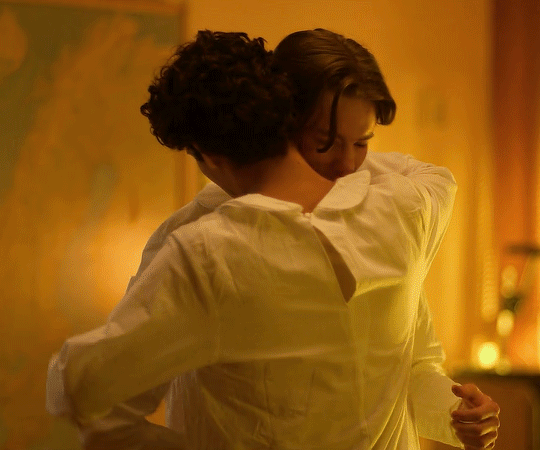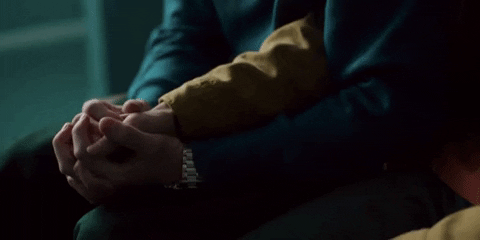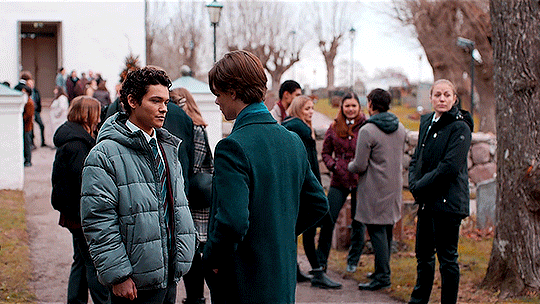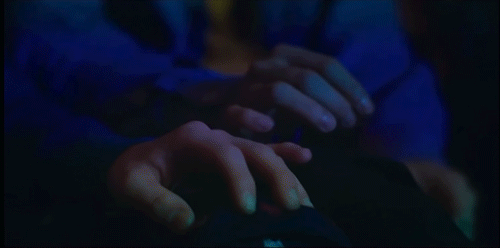#also not necessarily my favourite song from walls but that part in the second verse when he performs live lives rent free in my head
Photo

Away From Home Festival Moodboard:
Louis performs your favourite song
↳ Walls
#inthemoodforafhf#TracksintheAM#trackinghome#raetracks#trackinghappily#usertan#userindomie#usermoo#userpink#dailytomlinson#LFLtracks#away from home festival#louis tomlinson#louisupdates#1dsource#dailydirectionedit#nusaibah makes stuff#i made gifs too :D#also not necessarily my favourite song from walls but that part in the second verse when he performs live lives rent free in my head#also v happy with how the gifs are in sync#im pretty with this as a whole
351 notes
·
View notes
Text
👑Young Royals👑
Just a hodgepodge of asks to get to know your favourites and gush some more about YR (one day it will be enough right?). Share your thoughts dears! 💜
Thanks for the tag @ladyauroraborealis 🥰
Favourite:
Kiss

I completely agree with Lana. The smile right before the kiss. Ugh it’s just so sweet
Hug

Wille grasps onto Simon like he thought he was going to lose him. There’s so much desperation but just to hold Simon and be held by him. He so badly wants everything to be okay
Foreheads touching

It’s so delicate and sweet. And everything else going on just makes it so heartbreaking
Hand holding

They’re both seeking comfort in each other and just desperately trying to hold on to each other
Wille and Simon outfits
For Simon the purple hoodie (obviously) and for Wille the blue and black sweater
OST
This song perfectly conveys their emotions in the scene and it’s just so pretty to listen to (but honestly that’s true for all of them)
Share a moment that
Made you cry (happy or sad tears)

I never actually cried while watching yr but this scene was the closest I got to actual tears
Made you smile big
Honestly every single cute wilmon moment. Theres not a single one of them I can watch without smiling like a complete idiot
Made you want to throw your screen against a wall

I remember the first time I saw this part I legitimately screamed. The whole circumstances of their situation and then the confession of love just got me feeling a whole lot of emotions
Fish scene or morning after scene?
The morning after scene. It ranks high in my favourite scenes across all film/tv
Moment you knew this show was something special

This scene holds a special place in my heart. The technical aspects are amazing and as soon as I saw it I knew this show would ruin me
Quote you love
Jag bara vill inte förlora dig. Du är den enda som jag känner att jag faktiskt kan prata med här
Who would you want to be friends with first (or be BFFs) if you went to Hillerska?
I feel like I would probably get along best with Simon
Pick a song you like that you feel could be Wille’s, Simon’s, or Wilmon’s anthem
So for Wilhelm I think Bloodline fits really well with his season 1 storyline. He keeps pushing against the grain to follow his heart but ultimately caves into what he’s expected to do
I strongly believe Wille is going to fuck shit up in season 2 and I am so here for it. I also found this song thanks to @grizviser gaslight, gatekeeper, girlboss playlist that has loads of other great anthems for Wille in season 2
This song is so good and when I translated the lyrics I thought it fit with Simon especially in season 1. He’s so empathetic and he deals with Wille’s inconsistency and ultimately gets hurt in the end
For season 2 I think Simon is going to be trying really hard to move on from Wille but he does truly love him so it’s not going to go away easily. It’s the I love you even though I don’t want to (until they get back together of course)
I saw someone else (sorry I don’t remember who) mention Like Real People Do for Wilmon and I haven’t been able to stop thinking about it because I think it fits really well for them in season 1
I think Fallout might fit well for Wilmon for at least half of season 2. Like I think the first verse sounds very much what Wilhelm will be feeling and the second verse is more Simon. And I know we don’t want a love triangle but the jealousy implied in the song also fits (and it doesn’t necessarily have to refer to a love triangle)
And a little extra but I hope (maybe for season 3) that their relationship gets to the point where this song works perfectly
Show me a scene that when you see it, makes you want to rewatch the show right then and there

The fish scene is probably the scene I see gifs of most often and every single time I want to rewatch the show
I’m tagging @gold-rush-wille @goldenwilmon @whatintheeverlovingfucketh @eyeofthedrgn and anyone else who wants to participate!
41 notes
·
View notes
Video
youtube
This week on Great Albums: a stupendously underrated classic of queer punk meets synth sophistication, and an album without which we wouldn’t have Dare by the Human League: Homosapien, the 1981 solo opus of Buzzcocks frontman Pete Shelley. Find out more by watching the video, or reading the transcript below!
Welcome to Passionate Reply, and welcome to Great Albums! Today, I’ll be talking about one of those albums that isn’t necessarily the most acclaimed or best remembered work of its period, but nonetheless played an important role in history, and remains unrivaled for its uniqueness: Pete Shelley’s Homosapien, first released in 1981.
Shelley has historically been chiefly remembered as the frontman of the punk act, Buzzcocks. But, despite punk’s reputation for simplicity to the point of obnoxiousness, Shelley was one of many musicians to come from the punk scene with a penchant for experimental or otherwise ground-breaking music. His very first solo release, 1980’s Sky Yen, features little more than a brash wall of oscillating electronic noise, not unlike the earliest provocations of industrial artists like Cabaret Voltaire.
Music: “Sky Yen (Part One)”
Subsequent generations of critics have gone great lengths to coin and define terminology, in the hopes of breaking this period down into constituent parts, but the more I study it, the more I’m inclined to view it as just a huge soup. There was, quite simply, a lot going on in Britain’s underground in the late 70s and early 80s, and in practice, the lines between punk, post-punk, industrial, synth, noise, and other avant-garde miscellany are frequently illegible. As an artifact of this era, Homosapien resonates with all of the contradictions this melting pot would imply, fusing emotional rawness and pristine production in a way that never quite settles down and feels comfortable.
Music: “I Don’t Know What It Is”
“I Don’t Know What It Is” served as the opening track of the album’s second side, as well as its lead single. With a bona fide guitar solo as well as a propulsive, and truly soaring, chorus, it somewhat resembles that most 1980s of art forms, the power ballad. It is, ostensibly, a love song, and is revealed to be one quickly enough, but its portrayal of love is far from kind. While a real power ballad might take the concept of love for granted, “I Don’t Know What It Is” seems to portray it as something mysterious, inscrutable, and dangerous. And I can’t forget to mention just how much Pete Shelley stands out as a vocalist--his high-pitched, perhaps even fried or shrill vocals add a great deal to the song’s sense of unease, and really sell the idea of someone who’s being overtaken by an uncontrollable and dominating force.
Of course, perhaps the most noteworthy thing about Homosapien’s sound is its fusion of the hard, driving acoustic guitar of punk with the electronic sensibilities of its producer, Martin Rushent. I wouldn’t say this combination is ever terribly cohesive in its sound, but I think that’s why I find this album so interesting: there’s a tension that permeates each track, a feeling that things don’t fit together. While Homosapien is a pioneering work of electronic-centered production, enough of the pieces are still in place that you can certainly hear the shape of music to come as you listen to it. It’s not just the synthesisers, but also the use of electronic percussion here--it’s difficult to overstate the impact that so-called “drum machines” had around this time. While reviled by many, both then and now, rhythm machines were undeniably “instrumental” in changing what popular music sounded like. Even synthesiser-based electronic acts like Gary Numan, OMD, and Kraftwerk often relied on traditional percussion, so this genuinely was pretty shocking at the time.
Perhaps the most important element of the legacy of Homosapien is the fact that Martin Rushent would go on to use the skills he honed here to produce one of the most influential albums of the 1980s, and perhaps of all time: The Human League’s Dare, which would go on to cast an enormous shadow on nearly all popular music to come, after playing an enormous role in instigating an era of popular dominance of synth-pop. In that sense at least, Homosapien is certainly a very historically important album, and for that reason alone, I think it deserves a fair bit more attention than it gets. Still, for as much as the electronics might be the most forward-looking element of this album, one also can’t deny that it remains full of aggressive and perfectly punk overtones, as on the crass or perhaps dismissive screed of “Guess I Must Have Been In Love With Myself.”
Music: “Guess I Must Have Been In Love With Myself”
While Homosapien has many moments of seemingly being too thorny to get a good grip on, that doesn’t mean that there aren’t also times in which it can feel like a bit more than the sum of its apparent parts, as on its most narrative-driven track, “Pusher Man.”
Music: “Pusher Man”
“Pusher Man” is one of, if not the, most synth-centered compositions to be had on Homosapien, but its insistent pacing and neurotic portrayal of the “low life” theme of buying illicit drugs mean you’ll never confuse it for run of the mill synth-pop. Moreso than anything else the album offers, this track reminds me of the sort of “synth-punk” that American acts like the Units and Crash Course In Science would put forward at around the same time. “Pusher Man” was, at the very least, a sufficiently experimental track to earn the honour of being cut from the US release of the album in order to make room for some non-album A-sides, as happened to many albums at the time. But hey, that’s enough beating around the bush. Let’s talk about the real crown jewel of this album.
Music: “Homosapien”
If you’ve heard anything from this album before, chances are, it was probably the title track, which proved to be quite the commercial success--despite being banned by the BBC on account of its homoerotic content. Given that this very same year, they also came after OMD’s “Enola Gay” for its obviously nonexistent reference to homosexuality, one might be forgiven for thinking that a tune called “Homosapien” was simply misinterpreted. The title track isn’t terribly explicit material, but its clever wordplay nonetheless deals quite deftly with issues of sexuality and personal identity. In the earlier verses, Shelley introduces us to typified roles of gay male sexuality--the “cruiser,” the “shy boy”--only to seemingly doff them with the tune’s defiant refrain, asserting that the only truly important identity a human being has is that of “Homosapien.” Far from being an unfortunate coincidence, the similarity of “Homosapien” to “homosexual” is being employed here completely deliberately, particularly with it being mashed into a single word and thus gaining a greater resemblance to the word “homosexual” in print. It not only allows Shelley to belt out a borderline dirty word, but also creates a sort of unconscious syllogism, suggesting, in a sense, that homosexuals are people too.
With elements of both unapologetic pride in one’s own queerness, as well as the uncompromising assertion that humanity is something much deeper than that, the title track of Homosapien is one of the most fascinating and inspiring queer anthems of its time. Its artsy slipperiness has prevented it from feeling more shallow with time, and its straightforward or raw quality, intensified by that constant acoustic guitar, has kept it sounding equally sharp. It genuinely does surprise me that this album isn’t at least a little bit better remembered than it is. Outside of the title track, most of this album is currently not available on services like Spotify and YouTube Music at the time of this writing, and I actually struggled to present musical examples here. That’s really a pretty high level of neglect in this day and age, and I hope it can be rectified in the relatively near future.
It would be no exaggeration for me to say that Homosapien features some of my very favourite cover art of any album. Homosapien’s sleeve design sees Shelley occupy some sort of sleek, but hollow hyper-modernist office. Geometric forms suggest the world of the artificial or ideal. An Egyptian statue beside Shelley is a reminder of history, and the idea that even the greatest empires must eventually fall. Likewise, the telescope and early computer positioned nearer to Shelley are evocative symbols of science and technology--but in context they seem more sinister, being juxtaposed against a phrenology bust, which evokes the ways in which our attempts at science have caused misunderstanding and great human misery in the past. The central scene is framed in with large areas of black, which make the space feel even more claustrophobic and uninviting, and Shelley appears to be pushed into the background, almost belittled by the inanimate objects. Overall, I think it’s sort of funny that this album’s cover is perhaps more iconally “New Wave” than the music itself ended up being, particularly with Shelley clad in this somewhat foppish white suit and bow tie--certainly a big change of attire for a former punk!
Given the experimental nature of the collaboration between Shelley and Rushent, you might be surprised to learn that Homosapien actually wasn’t a one-off. Just two years later, Shelley would release a follow-up LP, XL-1, which was also produced by Rushent and largely continues the same ideas. While Shelley would never see the success of “Homosapien” again, the XL-1 single “Telephone Operator” would also chart to a lesser degree.
Music: “Telephone Operator”
My favourite track on Homosapien is “Qu’est-ce que c’est que ça,” which closes out the first side of the album. If you’re familiar with my other work, you probably already know that I’m coming at this as someone chiefly interested in the electronic side of things, and I think that of everything on this album, “Qu’est-ce que c’est que ça” is the closest to being convincing as a synth-pop tune. With a bubbly, synth-dominant sound and lyrics that are more contemplative than aggressive, it’s much closer to the mould of what I usually listen to for fun than a lot of the other tracks are. That’s everything for today--thanks for listening!
Music: “Qu’est-ce que c’est que ça”
9 notes
·
View notes